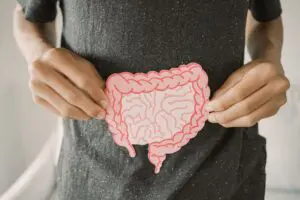THE GUT-BONE AXIS
By Ross Pelton, Rph, Phd, CCN
Director of Research and Science for EFI
Feb 21, 2018 – According to statistics from the National Health and Nutrition Examination Survey 2005-2010, approximately 54% of the US adult population ages 50 years and older have low bone mass or outright osteoporosis. The cost to American taxpayers is enormous because Medicare pays for 80% of broken bones that result from osteoporosis.i Experts are predicting that by 2020 the incidence will grow from 54 million Americans to 64.4 and by 2030, the number is expected to increase to 71.2 million (a 29% increase from 2010).
Osteoporosis-related fractures take an enormous emotional toll and seriously compromise quality of life for millions of people. In addition to hospitalizations and placement in nursing homes, fractures like a broken hip frequently start a downhill slide that results in death.
The GUT-BONE AXIS: Link Between Digestive Health & Bone Health
Many people and probably most doctors are not aware of the close relationship between gut health and bone health. Digestive complaints are among the most common reasons for trips to doctors and hospitals. Government health statistics estimate that from 60 to 70 million Americans suffer from digestive diseases.ii
Acid/Base Balance: Calcium & Magnesium Mineral Absorption
The level of acidity in the gastrointestinal tract is a critical factor that links GI health with bone health. Various strains of your beneficial probiotic bacteria produce compounds called short-chain fatty acids, which we also refer to as postbiotic metabolites. These weak acidic compounds create the optimal level of acidity in the GI tract for the absorption of minerals such as calcium and magnesium that are required for the building and maintenance of healthy bone.
Inflammation Lowers Bone Density & Increases Osteoporosis Risks
Inflammation can occur locally in the intestinal tract, or systemically throughout the body. Inflammation in the GI tract can result in nutritional deficiencies which can increase the risk of osteoporosis. High sensitivity C-reactive protein (hs-CRP) is a marker of systemic inflammation. Elevated levels of hs-CRP are associated with lower bone mineral density and osteoporosis.iii
An unhealthy diet and bad bacteria are two of the main causes of inflammation in the intestinal tract. In addition to eliminating inflammation-causing foods, it is also important to insure that your intestinal tract is inhabited primarily with friendly probiotic bacteria. One of the benefits of the short-chain fatty acids produced by probiotic bacteria is that they have anti-inflammatory activity.iv
Elevated Homocysteine & Osteoporosis Risk
Elevated homocysteine is a known risk factor for osteoporosis and deficiencies of the following B-vitamins, vitamin B6, B12 and folic acid are associated with elevated homocysteine.v Certain strains of beneficial probiotic bacteria are known to synthesize these homocysteine-metabolizing B-vitamins in the human intestinal tract.vi Therefore, things that upset the microbiome and decrease the number of beneficial B-vitamin synthesizing probiotic bacteria can contribute to elevated homocysteine and increased risk of osteoporosis. Risk factors include antibiotics, other microbiome disrupting drugs such as PPIs, H2-blockers and NSAIDs, and numerous unhealthy lifestyle habits such as poor diet, lack of exercise and high stress can increase risks of osteoporosis and fractures.
Vitamin K & Bone Health
Vitamin K plays critical roles in numerous aspects of bone health and vitamin K deficiency is associated with osteoporosis.vii Scientists have learned that some strains of intestinal bacteria produce vitamin K in the human intestinal tract. Furthermore, studies have documented that bacterially synthesized vitamin K is absorbed from the intestinal tract, and thus contributes to human nutritional vitamin K requirements.viii Therefore, it stands to reason that antibiotics and other factors that contribute to dysbiosis will lower vitamin K levels and be a contributing factor in declining bone health.
Dr. Ohhira’s Probiotics Increase Bone Density
In 2003, a study titled The Influence of Lactic Acid Bacteria (Dr. Ohhira’s Probiotics) on Bone Structure was published in the Journal of Applied Nutrition. The study participants included 157 men & women (aged of 20 to 60 years old) took Dr. Ohhira’s Probiotics daily for 24 months. Bone density measurements were taken at two locations, the radial and ulna bones. At the end of this study, the following was reported:
- Women increased bone mineral content by 32% and bone density by 18%
- Men increased bone mineral content by 22% and bone density by 12%.
Kawakami M, Ohhira I, et al. The Influence of Lactic Acid Bacteria (Dr. Ohhira’s Probiotics) on Bone Structure. Journal of Applied Nutrition; 53(1): 2003.
CONCLUSION:
Healthy gut & healthy microbiome are required for healthy bones.
There is a direct and important relationship between digestive health and bone/skeletal health. Probiotic bacteria and the human microbiome control numerous factors that regulates bone/skeletal health such as inflammation that can occur in the gastrointestinal tract as well as systemically throughout the whole body. Probiotics and the microbiome also regulate the production and absorption of nutrients that are critical for the growth and maintenance of healthy bones.
References:
i National Osteoporosis Foundation Press release June 2, 21014. NOF Releases Updated Data Detailing the Prevalence of Osteoporosis and Low Bone Mass in the U.S.: 54 Million Americans Affected by Osteoporosis and Low Bone Mass.
ii National Institutes of Health, U.S. Department of Health and Human Services. Opportunities and Challenges in Digestive Diseases Research: Recommendations of the National Commission on Digestive Diseases. Bethesda, MD: National Institutes of Health; 2009. NIH Publication 08–6514.
iii Koh JM, et al. Higher circulating hsCRP levels are associated with lower bone mineral density in healthy pre- and postmenopasal women: evidence for a link between systemic inflammation and osteoporosis. Osteoporos Int. 2005 Oct;16(10):1263-71.
iv Vinolo M, et al. Regulation of Inflammation by Short Chain Fatty Acids. Nutrients. 2011 Oct;3(10):858-876.
v Ebesunun MO, et al. Plasma homocysteine, B vitamins and bone mineral density in osteoporosis: a possible risk for bone fracture.
vi LdBlanc JG, et al. Bacteria as vitamin supplier to their host: a gut microbiota perspective. Current Opinion in Biotechnology. 2013 April;24(2):160-168.
vii Adams J, Pepping J. vitamin K in the treatment and prevention of osteoporosis and arterial calcification. Am J Health Syst Pharm. 2005 Aug 1;62(15):1574-81.
viii Conly JM, et al. Intestinal Bacteria Synthesize Vitamin K2. Am J Gastroenterol. 1994 Jun;89(6):915-23.






